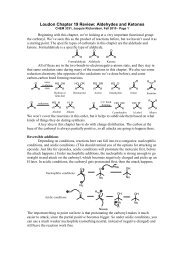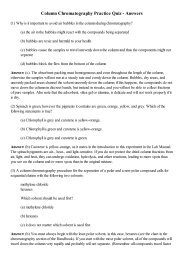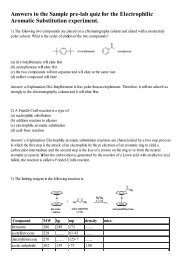7 - Isolation of Limonene.pdf
7 - Isolation of Limonene.pdf
7 - Isolation of Limonene.pdf
Create successful ePaper yourself
Turn your PDF publications into a flip-book with our unique Google optimized e-Paper software.
Experiment 7: <strong>Isolation</strong> <strong>of</strong> <strong>Limonene</strong><br />
Polarimetry<br />
Chiral, non-racemic compounds have the ability to rotate polarized light. This phenomenon is known as<br />
circular birefringence, and is where the phrase “optically active” comes from. The specific rotation <strong>of</strong> a<br />
material is an intrinsic, constant value at a given temperature and wavelength <strong>of</strong> light; specific rotation<br />
can be found by using polarimetry. The polarimeter consists <strong>of</strong> a glass tube with flat ends to hold the<br />
sample, and a polarizing filter at each end <strong>of</strong> the tube. A light is shone onto the mirror at the bottom<br />
end <strong>of</strong> the polarimeter. As the light passes through the first filter it is polarized into a single direction,<br />
but this direction changes as it travels through the tube (if the sample is optically active). When it<br />
reaches the second filter, it may or may not pass through depending on whether it is polarized in the<br />
same direction as the second filter. The second filter is attached to an eyepiece which can be rotated,<br />
causing more or less light to pass through. At the darkest point, a reading can be made from the<br />
markings on the eyepiece which gives the observed rotation.<br />
Specific rotation, [α], is then given by the following formula:<br />
α = α<br />
l ∙ c<br />
where α is the observed rotation in degrees, l is the path length <strong>of</strong> the polarimeter tube in decimeters,<br />
and c is the concentration in g/mL. The literature value for the specific rotation <strong>of</strong> limonene is 124°.<br />
The polarimeter tubes that you will use have a path length <strong>of</strong> 12 cm, or 1.2 dm, and they contain a<br />
volume <strong>of</strong> 35 mL. Your TA will demonstrate how to take a reading on the polarimeters.<br />
Safety Precautions<br />
Pure limonene is an irritant, especially to the eyes, and it is flammable. Ethanol is flammable and toxic.<br />
Be careful that you do not cut yourself with the knife or peeler you use to remove the rind from the<br />
oranges; peel away from yourself, not towards yourself.<br />
Procedure<br />
Peel an orange with a sharp knife or peeler. Remove just the exterior, brightly colored portion <strong>of</strong> the<br />
peel, called the “zest”, as the white material underneath (the pith) contains little or no limonene.<br />
Determine the mass <strong>of</strong> the peelings then place them in a blender. Add about 50 mL water, put the lid on<br />
the blender, and blend the mixture until a smooth puree is obtained. Pour 50mL <strong>of</strong> this puree into your<br />
100 mL round-bottom flask. (It is not necessary to get all the solids into the flask – much <strong>of</strong> the<br />
limonene will be in the liquid, if you have blended it enough). Add several boiling chips. Attach the flask<br />
to the steam distillation system shown in Figure B.5. Use a 10mL graduated cylinder for the receiving<br />
flask.<br />
Place a heating mantle under the distillation flask, connect the heating mantle to a Variac, and heat to<br />
boiling (Variac setting 60-70). Do not heat the flask too quickly, as this may cause the contents <strong>of</strong> the<br />
distillation flask to bump and contaminate the product. If this happens you will have to let the apparatus<br />
cool down, pour all the recovered distillate back into the distillation flask, clean the collection flask and<br />
condenser, and begin again.<br />
Periodically add 5 to 10 mL portions <strong>of</strong> water to the distillation flask to replace the water that has been<br />
distilled over. Try to maintain the liquid level in the distillation flask at about half-full. You can add<br />
40













